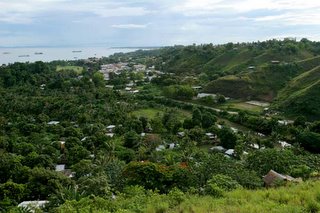
Besides divers, the only other travelers the Solomons, and Guadalcanal in particular, have ever attracted in numbers are former GIs, drawn to the steep hills where their fellow soldiers died by the thousands, rushing up without cover to claim the hilltops from the Japanese. James Jones’ The Thin Red Line (and the Terence Malick movie based on it) was set against this backdrop. Today, the rusting remnants still litter Guadalcanal where a great deal of fighting, on both sea and land, took place within a relatively small area, including all of sprawling Honiara. When people dig to lay the foundation for a building, they routinely find bodies. Expats wander old battlefields with metal detectors looking for souvenirs. Antiquated (even in 1942) Japanese cannons and small American tanks with popped treds settle to the earth in front of homes. A well-manicured golf course near the coast was once a series of fighter strips and is built on mounds of old jeeps and equipment. The bunker-like shed that was the American command post for the island is now a makeshift toilet along a rutted and pocked back road. The same remains provide the iron of Iron Bottom Sound. Out there, under the gentle waves and the Chinese fishing ships, are dozens of American and Japanese ships and probably hundreds of planes.
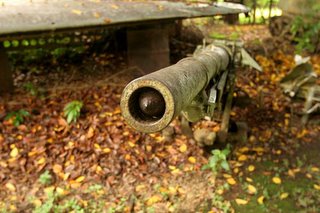
Honiara itself was a US supply depot and everywhere you turn, every patch of coast, every inland ridge, every broad flat field, has a name and a story and a battle associated with it. The flow of GIs who come to have a look at the past has slowed in recent years, for obvious reasons besides the “tension.” The Solomon Islanders, who welcomed the Americans as a more humane alternative to Japanese occupation, are forgetting this time even more rapidly. A young population growing up with these rusting hulks around them has, I think, more pressing concerns.
In summer 1942, US troops arrived in Guadalcanal, where the Japanese had recently dug in. The Japanese responded quickly with a naval attack, one of six major naval battles here. The Battle of Savo was a serious defeat for the US and claimed 1270 American lives. Slowly American forces recovered and eventually claimed Guadalcanal. In six months, 67 boats had been sunk, and 7,000 American and 30,000 Japanese soldiers were dead--drowned or blown up or shot down or quaking in their cots with malaria.

The only part of the memory of Guadalcanal not currently decaying in some form is the US War Memorial, which is maintained by an American agency for the preservation of monuments. Gareth took a couple of us up there and to a few other WWII sites yesterday morning after I finished with the dawn dive. Apparently it has suffered badly during the “tension,” but is now in great shape. A series of marble slabs with text explaining all the significant battles in the war surround a tomb for an unidentified soldier; the memorial provides a wonderful (and incredibly strategic) view out over all of Honiara on one side and a series of lumpy ridges, visible in this image, that the GIs scrambled up on the other.
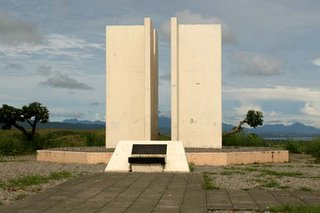
Later, we visited the Japanese War Memorial, which is decidedly less impressive. While it provides another great view, it lies on the other side of a very dodgy neighborhood and is never maintained. It has become a graffiti-covered drinking spot littered with broken glass. With this exception, I noticed Japan has a very visible presence here now; the country donated everything from the airport to the computers in the Internet café.
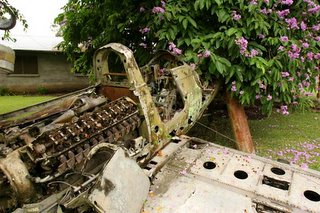
Gareth also took us to see a few places where some of wrecks that were not dumped at sea or built over are amassed. They’re unmistakably beautiful as they settled into the earth, and I’m amazed that they’ve lasted as long as they have in this climate. This plane, a P39 Aerocobra, was a strange one. Unlike most WWII fighter planes, which have their engines mounted in the front, its engine was mounted in the middle and the drive shaft for the propeller ran between the pilots legs (!). It also had two machine guns that fired through the propeller blades and a cannon mounted in the center of it.
Then this morning, I saw just a fraction of what sits on the bottom of the sound. We made three dives of WWII wrecks--two Japanese transport ships called Bonege I and II and an American bomber (a B19, I thought I heard, but was unable to confirm). These wrecks have been down substantially longer than any others I’ve dived on, and as they slowly cave in, the ocean life has taken over. Some jagged rusty sheets and the general outline of the ships still shows through, but they are now very active reefs, covered in fish, corals both hard and soft, shrimp minding holes and anemones, and the occasional octopus flitting by. Bonege I is probably the most popular dive spot in the Solomons, easily accessible from shore near Honiara and extending from 30 feet to 150 feet. Bullets can still be found in the sand. We had planned to visit the hold, where there is a jeep, but lacked a flashlight powerful enough to cut through the gloom. I particularly enjoyed and was moved by the plane we saw later. Most of the nose and tail were missing, but the cockpit (including the throttle and steering wheel) and wings were intact, as well as some of its heavy machine guns and engines. But it has been totally consumed by life--it is like a quaint oasis in a desert of sand. There is a rumor that this plane was sunk in deeper water, but brought shallower for salvage. That is something almost never done, and the rumor was that a “briefcase” (plans, maps, etc.) that was pulled out. Could just be a local legend to embellish a nice little diving spot. I’ve been told about the dozens of other wrecks, divable and not, but unfortunately I’ll have to make due with what I saw today.
Steeped as I have been in WWII lore, I also made it a point yesterday afternoon to stop by the National Museum, which has a collection of tens of thousands of artifacts from the dozens of distinct cultures that make up the Solomons. By way of reference, there are more than a hundred indigenous and distinct languages spoken here. And because a lot of the outer islands have kept back from the violence on Guadalcanal and generally avoided developing a cash economy, many of these traditions--dances, initiations, body art including tattooing and piercing--survive uncorrupted. Unfortunately, all but a handful of the objects are still in storage for safekeeping, as they have been since the “tension” began. There have been a few things stolen or damaged, but most of the collection is intact. Much of what I saw were spears, shields and war clubs. I’ve read that until the 1930s, this area was considered among the most dangerous in the world--the people were headhunters and cannibals and skull worshippers. Hard to reconcile that image with the friendly people I meet here now. The one staff member at the museum told me they are considering a new exhibition for next year. More interesting than the sparsely populated exhibition space, though, is the park in back with examples of building styles from all over the archipelago.
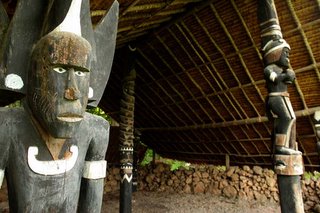

5 Comments:
Just went to the Saigon war museum. Let's just say it takes a different view than the monuments you saw.
Folino
I can imagine. Different war, different times.
It seems like the adventure you had planned is finally happening. The wrecks must be amazing to dive.
Keep safe.
jyp
i bet you wish they had starbucks.
and some Jack Daniels!
what is the booze situation there?
Post a Comment
<< Home